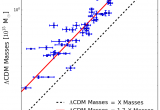What’s the matter with Galaxy Clusters ?
To reconcile the standard cosmological model with the X-ray measured number of galaxy clusters, a team of French scientists has shown that the cluster masses should be increased by 70% compared to current estimates. These results follow the conclusions obtained by the Planck mission in 2013 from observations of galaxy clusters in the microwave domain. This huge difference is intriguing: either our understanding of the physics of galaxy clusters needs to be revised, or the standard cosmological model is incomplete.
Cosmic microwave background observations by the Planck satellite have established the standard cosmological model with unprecedented precision. This model allows us to predict the number of cosmic structures (galaxies, clusters of galaxies, etc.) formed by gravitational collapse. In particular, the present-day abundance of galaxy clusters can be predicted and compared with observations. In 2013, such a comparison has been made between theoretical predictions and the number of clusters actually detected in Planck, at intermediate cosmological distances, thanks to their microwave signature, that is through the so-called SZ effect. The team, led by IAS scientists, showed that if the hydrostatic mass estimate is used, the predicted number of clusters is three to four times bigger in the standard cosmological model than the number of SZ-detected clusters [1]. One solution to reconcile theoretical predictions and observations is to consider that true cluster masses are 70% larger than those estimated. At this time, the reason for this mismatch is not understood. Another possibility is that neutrinos, through their tiny non-zero mass, help suppressing the mismatch.
We have addressed the problem with a different approach [2]. We first selected a sub-sample of local clusters and computed their number as a function of their temperature. We then computed the masses required for this number of X-ray selected galaxy clusters to be in agreement with the prediction of the standard cosmological model. We finally compared these masses with the current estimates and showed that, indeed, the true masses should be 70% larger.
This demonstrates the good agreement between X-ray and SZ observations of galaxy clusters, but puts once again into question the limits of the standard cosmological model or our correct understanding of the physics of galaxy clusters.
[1] Planck Collaboration, Planck results 2013 : XX, A&A 571, A20, 2014
[2] S. Ilic, A. Blanchard, M. Douspis, X-ray galaxy clusters abundance and mass-temperature scaling, Astronomy and Astrophysics, 582,A79, doi:10.1051/0004-6361/201526793.
CNRS/INSU release : http://www.insu.cnrs.fr/node/5489
[[{"type":"media","view_mode":"media_responsive","fid":"453","attributes":{"alt":"","class":"media-image","height":"734","typeof":"foaf:Image","width":"726"}}]]
Required masses of selected galaxy clusters to fit the ΛCDM predicted number of local galaxy clusters (Y-axis), as a function of the current hydrostatic mass estimation from X-ray observations (X-axis). The red line shows that the required masses are 70% larger than the current estimates.




